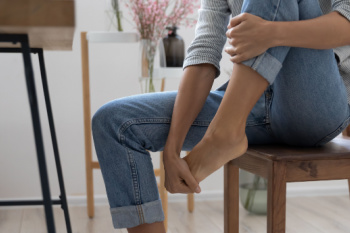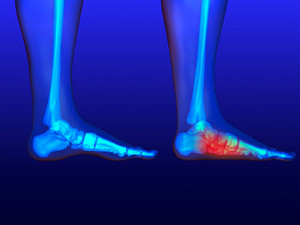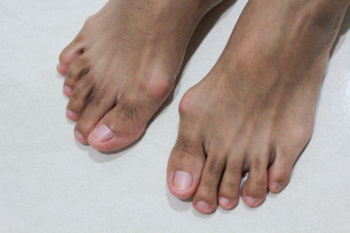Connect With Us
Blog
Items filtered by date: September 2025
When Your Toes Pop and Crack

Hearing your toes crack when you move them can be unsettling, but in many cases, it is not a sign of something serious. The cracking or popping sound, known as crepitus, often occurs when small gas bubbles in the joint fluid collapse or burst as the toes bend. This can come on with age, is usually harmless, and does not indicate damage. However, frequent or painful cracking may point to an underlying issue. Crepitus can sometimes be related to joint stiffness, early arthritis, or wear and tear in the cartilage. Inflammation of tendons or ligaments surrounding the toes can also cause snapping or popping sensations. If you notice swelling, redness, or discomfort with the cracking, it may be a sign that the joints are under stress. While occasional toe cracking without pain is usually nothing to worry about, ongoing symptoms should not be ignored. If you have this condition, It is suggested that you see a podiatrist for an accurate diagnosis and advice on the best treatment options.
Toe pain can disrupt your daily activities. If you have any concerns, contact one of our podiatrists of Kokomo Foot & Ankle Center. Our doctors can provide the care you need to keep you pain-free and on your feet.
What Causes Toe Pain?
Most severe toe pain is caused due to a sports injury, trauma from dropping something heavy on the toe, or bumping into something rigid. Other problems can develop over time for various reasons.
Toe pain can be caused by one or more ailments. The most common include:
- Trauma
- Sports injury
- Wearing shoes that are too tight
- Arthritis
- Gout
- Corns and calluses
- Hammertoe
- Bunions
- Blisters
- Ingrown toenails
- Sprains
- Fractures (broken bones)
- Dislocations
When to See a Podiatrist
- Severe pain
- Persistent pain that lasts more than a week
- Signs of infection
- Continued swelling
- Pain that prevents walking
Diagnosis
In many cases the cause of toe pain is obvious, but in others, a podiatrist may want to use more advanced methods to determine the problem. These can range from simple visual inspections and sensation tests to X-rays and MRI scans. Prior medical history, family medical history, and any recent physical traumatic events will all be taken into consideration for a proper diagnosis.
Treatment
Treatments for toe pain and injuries vary and may include shoe inserts, padding, taping, medicines, injections, and in some cases, surgery. If you believe that you have broken a toe, please see a podiatrist as soon as possible.
If you have any questions please contact our office located in Contact Us . We offer the newest diagnostic and treatment technologies for all your foot and ankle needs.
Arthritis Can Cause Pain in the Feet and Ankles
How Common Are Flat Feet?
 Flat feet are common among babies. The arch generally develops at approximately age six, but flat feet can continue in ten percent of children through the teenage years. The noticeable signs your child may have flat feet often include stiff joints, the entire foot lying flat on the floor while standing, and possible pain while participating in sporting activities. There are patients who may develop arthritis from having flat feet, and this may be evident in the middle of the foot. If you have symptoms of flat feet, it is suggested that you are under the care of a podiatrist who can guide you toward proper management.
Flat feet are common among babies. The arch generally develops at approximately age six, but flat feet can continue in ten percent of children through the teenage years. The noticeable signs your child may have flat feet often include stiff joints, the entire foot lying flat on the floor while standing, and possible pain while participating in sporting activities. There are patients who may develop arthritis from having flat feet, and this may be evident in the middle of the foot. If you have symptoms of flat feet, it is suggested that you are under the care of a podiatrist who can guide you toward proper management.
Flatfoot is a condition many people suffer from. If you have flat feet, contact one of our podiatrists from Kokomo Foot & Ankle Center. Our doctors will treat your foot and ankle needs.
What Are Flat Feet?
Flatfoot is a condition in which the arch of the foot is depressed and the sole of the foot is almost completely in contact with the ground. About 20-30% of the population generally has flat feet because their arches never formed during growth.
Conditions & Problems:
Having flat feet makes it difficult to run or walk because of the stress placed on the ankles.
Alignment – The general alignment of your legs can be disrupted, because the ankles move inward which can cause major discomfort.
Knees – If you have complications with your knees, flat feet can be a contributor to arthritis in that area.
Symptoms
- Pain around the heel or arch area
- Trouble standing on the tip toe
- Swelling around the inside of the ankle
- Flat look to one or both feet
- Having your shoes feel uneven when worn
Treatment
If you are experiencing pain and stress on the foot you may weaken the posterior tibial tendon, which runs around the inside of the ankle.
If you have any questions, please feel free to contact our office located in Contact Us . We offer the newest diagnostic and treatment technologies for all your foot care needs.
How Basketball Impacts the Lower Extremities

Basketball is fast-paced and demanding, making the feet and ankles especially vulnerable to injury. The constant running, jumping, and quick direction changes place significant stress on these areas, often leading to sprains, fractures, or tendon injuries. Ankle sprains are particularly common when a player lands awkwardly after a jump or rolls the foot on another player’s shoe. Stress fractures in the foot bones may also develop from repetitive impact on hard courts. Overuse injuries, such as Achilles tendonitis or plantar fasciitis, are frequent in athletes who train heavily without adequate rest. Even minor issues like blisters or bruised toenails can sideline a player, if not properly managed. Early evaluation and treatment are key to preventing long-term complications. Wearing protective footwear, strength training, and proper warm-ups can reduce the risk. If a basketball injury is causing pain in your feet or ankles or limiting performance, it is suggested that you see a podiatrist for diagnosis and appropriate treatment.
Ankle and foot injuries are common among athletes and in many sports. They can be caused by several problems and may be potentially serious. If you are feeling pain or think you were injured in a sporting event or when exercising, consult with one of our podiatrists from Kokomo Foot & Ankle Center. Our doctors will assess your condition and provide you with quality foot and ankle treatment.
Common Injuries
The most common injuries that occur in sporting activities include:
- Achilles Tendonitis
- Achilles Tendon Rupture
- Ankle Sprains
- Broken Foot
- Plantar Fasciitis
- Stress Fractures
- Turf Toe
Symptoms
Symptoms vary depending upon the injury and in some cases, there may be no symptoms at all. However, in most cases, some form of symptom is experienced. Pain, aching, burning, bruising, tenderness, tightness or stiffness, sensation loss, difficulty moving, and swelling are the most common symptoms.
Treatment
Just as symptoms vary depending upon the injury, so do treatment options. A common treatment method is known as the RICE method. This method involves rest, applying ice, compression and elevating the afflicted foot or ankle. If the injury appears to be more serious, surgery might be required, such as arthroscopic or reconstructive surgery. Lastly, rehabilitation or therapy might be needed to gain full functionality in the afflicted area. Any discomfort experienced by an athlete must be evaluated by a licensed, reputable medical professional.
If you have any questions please contact our office located in Contact Us . We offer the newest diagnostic and treatment technologies for all your foot and ankle needs.
What You Need to Know About Plantar Warts

Plantar warts are small growths that appear on the soles of the feet and are caused by the human papillomavirus, or HPV. The virus enters through tiny cuts or breaks in the skin, often in places like public showers, pool areas, or locker rooms. Symptoms include a thickened, rough patch of skin with a small black dot in the center, which is a clotted blood vessel. They may feel tender or painful, especially while walking or standing. Plantar warts can grow individually or in clusters and may be mistaken for calluses or corns. A podiatrist can diagnose plantar warts through a physical examination and sometimes remove a small portion to confirm the presence of the virus. Relief options include topical medications or minor surgical removal. Early treatment can help prevent the spread of the virus and reduce discomfort. If you notice a painful or unusual growth on your foot, it is suggested that you schedule an appointment with a podiatrist who can effectively treat plantar warts.
Plantar warts can be very uncomfortable. If you need your feet checked, contact one of our podiatrists from Kokomo Foot & Ankle Center. Our doctors will assist you with all of your foot and ankle needs.
About Plantar Warts
Plantar warts are the result of HPV, or human papillomavirus, getting into open wounds on the feet. They are mostly found on the heels or balls of the feet.
While plantar warts are generally harmless, those experiencing excessive pain or those suffering from diabetes or a compromised immune system require immediate medical care. Plantar warts are easily diagnosed, usually through scraping off a bit of rough skin or by getting a biopsy.
Symptoms
- Lesions on the bottom of your feet, usually rough and grainy
- Hard or thick callused spots
- Wart seeds, which are small clotted blood vessels that look like little black spots
- Pain, discomfort, or tenderness of your feet when walking or standing
Treatment
- Freezing
- Electric tool removal
- Laser Treatment
- Topical Creams (prescription only)
- Over-the-counter medications
To help prevent developing plantar warts, avoid walking barefoot over abrasive surfaces that can cause cuts or wounds for HPV to get into. Avoiding direct contact with other warts, as well as not picking or rubbing existing warts, can help prevent the further spread of plantar warts. However, if you think you have developed plantar warts, speak to your podiatrist. He or she can diagnose the warts on your feet and recommend the appropriate treatment options.
If you have any questions, please feel free to contact our office located in Contact Us . We offer the newest diagnostic and treatment technologies for all your foot care needs.
Dealing With Bunions

A bunion is a bony bump that forms at the base of the big toe, often leading to pain, swelling, redness, and difficulty wearing shoes. It may feel sore, stiff, or inflamed, especially after long periods of walking or standing. Bunions develop over time due to pressure on the joint, often from inherited foot structure, improper footwear, or repetitive stress. A podiatrist can diagnose a bunion through a physical exam and imaging, such as X-rays, to assess its severity. Treatment options include custom orthotics, changes in footwear, anti-inflammatory medications, or surgical correction for severe cases. Early intervention can help slow progression and relieve discomfort. If you notice a bump on the side of your big toe or are experiencing foot pain and changes in toe alignment, a podiatrist can help. It is suggested that you schedule an appointment for a full evaluation and personalized care plan.
If you are suffering from bunions, contact one of our podiatrists of Kokomo Foot & Ankle Center. Our doctors can provide the care you need to keep you pain-free and on your feet.
What Is a Bunion?
A bunion is formed of swollen tissue or an enlargement of boney growth, usually located at the base joint of the toe that connects to the foot. The swelling occurs due to the bones in the big toe shifting inward, which impacts the other toes of the foot. This causes the area around the base of the big toe to become inflamed and painful.
Why Do Bunions Form?
Genetics – Susceptibility to bunions are often hereditary
Stress on the feet – Poorly fitted and uncomfortable footwear that places stress on feet, such as heels, can worsen existing bunions
How Are Bunions Diagnosed?
Doctors often perform two tests – blood tests and x-rays – when trying to diagnose bunions, especially in the early stages of development. Blood tests help determine if the foot pain is being caused by something else, such as arthritis, while x-rays provide a clear picture of your bone structure to your doctor.
How Are Bunions Treated?
- Refrain from wearing heels or similar shoes that cause discomfort
- Select wider shoes that can provide more comfort and reduce pain
- Anti-inflammatory and pain management drugs
- Orthotics or foot inserts
- Surgery
If you have any questions, please feel free to contact our office located in Contact Us . We offer the newest diagnostic and treatment technologies for all your foot care needs.

